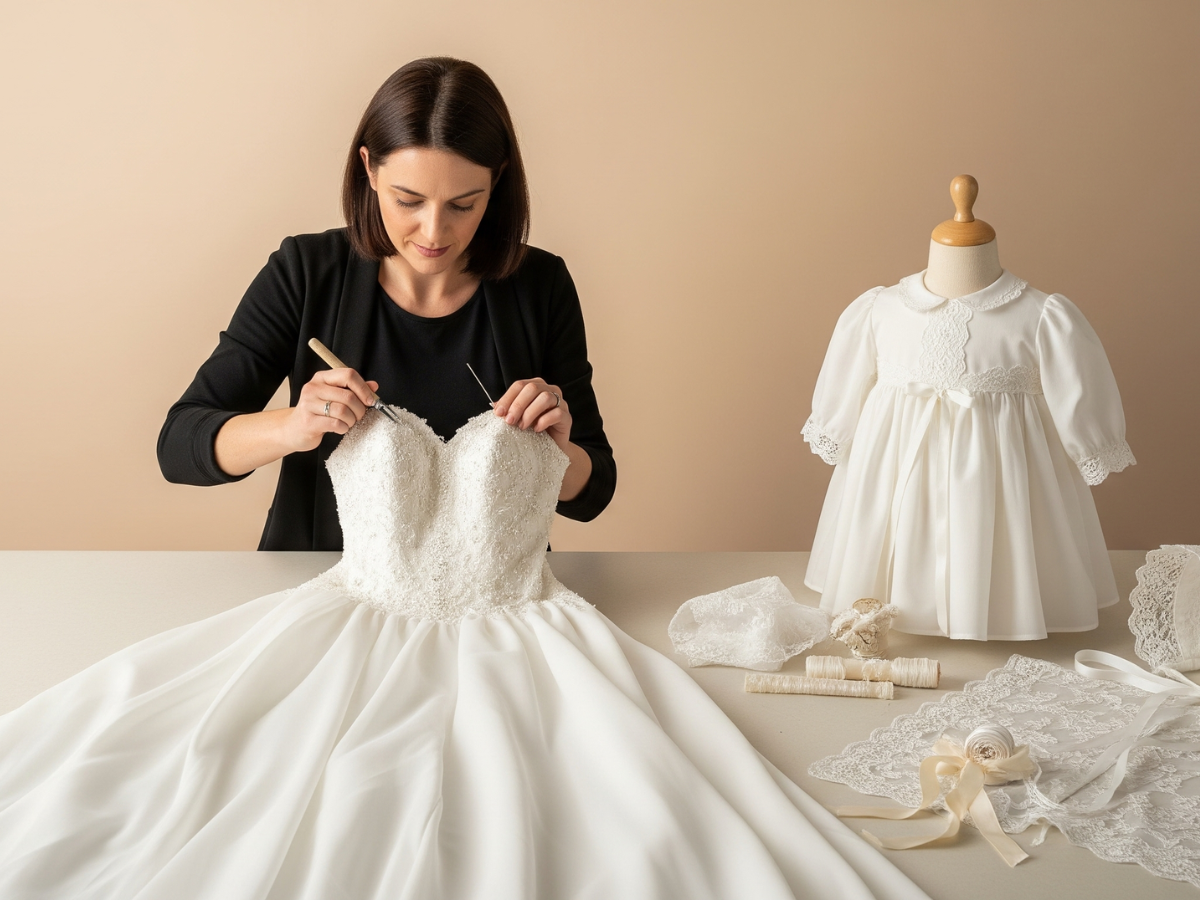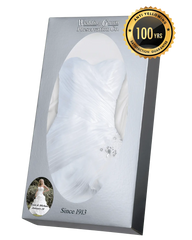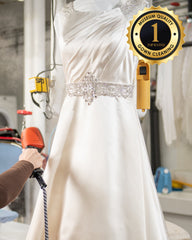What You’ll Learn in This Blog
-
How to tell if your preserved wedding dress is a good candidate for transformation
-
The best types of fabric for repurposing into a christening gown
-
A step-by-step DIY guide to creating the gown yourself
-
What to expect when working with a professional heirloom seamstress
-
Creative ideas for using leftover fabric in meaningful ways
-
How to care for your baby’s new heirloom after the ceremony
Long before your baby was born, even before the kicks and cravings and the ultrasound pictures on the fridge, there was another day when your hands trembled with joy and your story changed forever.
The day you walked down the aisle in the beautiful dress.
And when the day was over, you saved that dress. Carefully. Intentionally. Because something told you it wasn’t the end of its story.
Now, in the excitement and joy of your baby’s baptism day, you’re thinking of the same dress again, not as a gown for you, but as something far more tender. A christening dress for your little one, made from the very same fabric that holds your vows.
Because what began with you continues with them.
Is My Preserved Wedding Dress a Good Candidate for a Christening Gown?
Before anything is cut, stitched, or dreamed up, you’ll want to make sure your preserved gown is healthy enough for transformation.
Here’s a quick fabric check:
No yellowing or uneven discoloration
No brittle lace, especially near seams
No hidden stains (underarms, hems, bustle)
No dry rot or strong odors
If any of these red flags show up because of improper preservation of your dress, then a professional wedding dress restoration may be necessary first.
Professional fabric cleaning, fiber softening, or rehydrating treatments can help save compromised sections before repurposing.
Ideal Materials:
-
Lace - especially for trims, sleeves, or delicate overlays
-
Satin - smooth, structured, and timeless
-
Silk - light, soft, and perfect against a baby’s skin
-
Soft tulle - for dreamy little skirts or angelic accents
Planning the Transformation of the Wedding Gown

Creating a christening gown from your wedding dress is definitely more than a mere sewing project.
Decide if you’re ready to alter your entire dress.
Identify the most meaningful parts of your dress that you want to incorporate (lace, satin, buttons).
| Step | What It Means | Key Tips |
|---|---|---|
| DIY or Professional Help? | Choose who will craft the christening gown. |
DIY: Although it is more personal, it is riskier, especially if the fabric is fragile. Professional: More peace of mind since experts are experienced with heirloom work. |
| Sketch Your Vision | Decide on the style and emotional details. | If you’re planning a gown, romper, or unisex robe, include details like veil lace, sleeve buttons, or embroidered initials. |
| Select a Pattern & Prep | Ensure the outfit fits and feels right. | - Make a muslin mock-up to test fit. - Use or adapt a christening pattern. - Allow room for growth and comfort. |
DIY Roadmap: Step-by-Step Construction of a Christening Gown
If you’re sewing the gown yourself, this journey can be profoundly rewarding, but you need to approach this project carefully.
1. Careful Deconstruction
Use a seam ripper or close-cut method. Always work in natural light and go slowly. Make sure to preserve as much fabric as possible.
2. Cutting & Sewing
-
Use single-layer cuts on delicate fabrics
-
Finish raw edges with French seams for softness
-
Stabilize slippery fabrics with tissue paper underneath
3. Embellishment Transfer
-
Remove beads or crystals from seam areas
-
Use fabric glue or hand-stitching to place them securely
4. Finishing Touches
-
Line with soft cotton or muslin to protect the baby’s skin. Make sure only to use closures that will be snag-free, such as soft Velcro, fabric loops, or buttons.
-
Always make sure to test everything against your wrist or cheek before it touches the baby’s skin.
Working with a Professional Seamstress for Wedding Dress Alterations

If you’re not confident with scissors and stitches and are terrified of accidentally ruining your wedding gown, then relax! You’re not alone.
Most people turn to professional seamstresses to bring their vision to life with great care and precision.
How to Vet an Heirloom Artisan:
Look for a seamstress with a portfolio of christening gown transformations, and don’t be afraid to ask for references.
Look at client reviews on social media or Google. Ensure they communicate clearly and give written estimates.
What to Expect:
The typical process begins with:
-
A Consultation where you’ll share your wedding gown and the Christening dress design you’re dreaming of.
-
The artisan then shares their hand-drawn sketch or sample layout based on the consultation.
-
About 2-3 months of turnaround time
-
You can also expect many artisans to offer beautiful add-ons like a matching bonnet made from your veil’s lace.
Accessorize with Leftover Fabric from your Wedding Dress
Even the tiniest scraps hold big emotions. Once the christening gown is created, you can use the remaining fabric to make something more that’s just as meaningful.
Here are a few ideas:
-
A matching bonnet, booties, or a blanket
-
A soft swaddle wrap
-
A Detachable robe overlay
-
A ribbon for a future wedding bouquet
-
A framed lace swatch for the nursery
-
A pocket square or jewelry charm for your child’s wedding day
Check out what this Reddit user had to say about turning wedding gowns into baptism gowns and also making use of extra leftover materials.

Caring for the New Heirloom
Once the ceremony is over, the care journey begins again. A new chapter begins for the fabric that now holds two generations of love.
Cleaning
-
Gently clean the fabric with a baby-safe, bleach-free detergent and rinse thoroughly.
-
Lay it flat on a clean towel and let it air dry.
Storage
-
Softly stuff the gown with acid-neutral tissue paper
-
Avoid storing it in plastic bags that can trap moisture and cause damage over time.
-
Store it in a cotton muslin bag or an archival-quality, acid-free box.
-
Place in a dark, dry closet, away from light and heat.
Long-Term
-
Inspect once a year with cotton gloves and check for any signs of yellowing, wear, or other damage.
-
If it’s used again for a sibling or passed down to the next generation, consider re-preserving it through a professional Christening dress preservation service.
A Christening Dress That Carries More Than Memories
When the gown that once carried you down the aisle is the same fabric that carries your baby towards their blessings for new beginnings, it’s a full circle moment.
It represents the kind of love that doesn’t fade, but changes form and carries on.
In choosing to make your baby’s christening gown using your own wedding dress, you’re not letting go. Instead, you’re giving your child something that’s more than a mere garment.
You’re giving them a legacy that they can see and feel.
One day, it may even be passed on to the next generation.
Questions People Also Ask About Incorporating Wedding Gowns Into Christening Gowns
Can you repurpose a wedding dress?
Yes! Christening gowns, keepsakes, or even holiday wear are all meaningful ways to repurpose a gown.
How can I incorporate Mom’s dress without cutting it?
Use the veil as a wrap or trim. Try a detachable overlay, a bib, or a bonnet. These accessories can be created without altering the original gown.
What can I do with my wedding dress for my daughter?
Preserve it for her wedding, or use parts of it for her christening gown, communion dress, or future keepsake.
Is it safe to cut a professionally preserved gown?
Yes, it is safe if the fabric is in good condition. If there’s yellowing or brittleness, restoration is needed before any cutting.












 200 Business Park, Freehold, NJ 07728
200 Business Park, Freehold, NJ 07728
 (866) 308-8822
(866) 308-8822 info@trustedweddinggownpreservation.com
info@trustedweddinggownpreservation.com
